 |
Photo Gallery: Principality of Khachen
Click on thumbnail to enlarge image and see description.
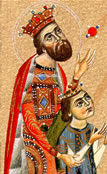
King Hetum I of the Armenian Kingdom of Cilicia (reigned from 1226 to 1270). Reproduction of a medieval Armenian miniature from Matenadaran—Armenia’s Institute of Ancient Manuscripts
|
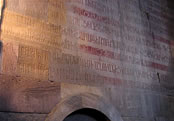
Hasan Jalal Vahtangian’s famous inscription on the interior of the northern wall of the Cathedral of St. John the Baptist. The text, in Old Armenian, reads: “In the name of the Holy Trinity, Father, Son and the Holy Spirit, I, Jalal Dola Hasan, servant of God, son of Vahtang, grandson of Hasan the Great, the native potentate of the high and broad province of Artsakh, King of Hohanaberd, with large districts, have ordered to inscribe these lines. Father of mine, before his departure from this world, ordered me and my mother Khorishah, daughter of Sargis the Great, Prince of Princes, to erect a church and [organize] the cemetery of our forefathers in Gandzasar, building of which began in the year 765 of the Armenian Calendar (1216) with the help of the Grantor of Benefits (God); and when we erected the wall above the windows, mother of mine abandoned secular life and departed for pilgrimage to Jerusalem for the third time, where, putting on the cilice and spending many years in reclusion near the Lord’s Temple, passed away on the day of the Holy Resurrection of Christ, and there was laid to rest. As to us, we, being aware of the danger of being idle, hurried to complete the construction work with the holy blessing of Merciful God, in the year 787 (1238)...” (Source: Bishop Makar Barkhudarian. Artsakh. Baku, 1885) |
|

Bas-relief of the Lion—a symbol of the Vahtangian princes of Artsakh, Armenia’s 10th historical province.
|
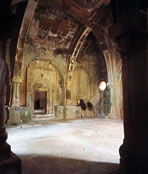
The Gandzasar Monastery: interior of the gavit.
|
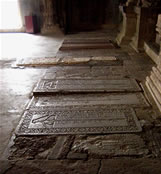
Tombstones of Grand Prince Hasan Jalal Vahtangian and top hierarchs of the Holy See of Gandzasar in the gavit
|
|
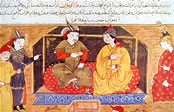
The Mongol Khan Hulagu (reigned from 1217-1265), the ill-famed “butcher of Baghdad”, with his Christian wife Dokuz. Miniature from Rachid Ad-Din’s History of the world, 14th century. Gandzasar’s patron Hasan Jalal Vahtangian, Lord of Khachen, both fought against and cooperated with Hulagu.
|
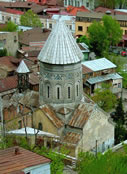
The medieval Armenian cathedral of St. Gevorg (St. George) in Tbilisi, capital of Georgia. The cathedral underwent fundamental renovation in 1251 under the patronage of the influential merchant Umek—Grand Prince Hasan Jalal Vahtangian’s son-in-law who married his daughter, Princess Mama. The cathedral currently serves as the center of the Diocese of Georgia of the Armenian Apostolic Church.
|
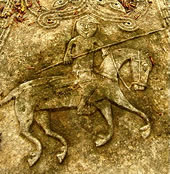
Protectors of the holy shrine of St. John the Baptist: Armenian commanders of the Principality of Khachen’s royal cavalry who defended Gandzasar, fighting against Seljuk Turkish and Mongol invaders in the 12th and 13th centuries. Funerary bas-reliefs at Koshik Hermitage and Gandzasar’s military cemetery. Photo by Boris Baratov. |

Royal Standard of the Principality of Khachen (Kingdom of Artsakh) during the reign of Grand Prince Asan Jalal Vahtangian (13th c.). At the center are the flag-wide “senior” white (silver) cross of St. John the Baptist and four “junior” crosses of St. John—symbols also used in the Armenian Kingdom of Cilicia, Khachen’s ally state. The four traditional Armenian ecclesial abbreviations point to the words Jesus, Christ, Lord and God. The flag uses an intense shade of orange known in Armenian as Tzirani (literary—“color of apricot”) that symbolized nobility. Reconstruction by ARACS.
|
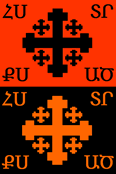
Military ensign of the Principality of Khachen (Kingdom of Artsakh) during the reign of Grand Prince Asan Jalal Vahtangian (13th c.) in two color versions—with black and golden crosses. At the flag’s center is a large cross of St. John the Baptist. The black color on flags symbolized self-sacrifice and detachment from earthly pleasures. The five crosses together represented the five wounds of the Christ during the Passion as well as the Lord of Khachen’s very personal connection to Jerusalem. The four traditional Armenian ecclesial abbreviations point to words Jesus, Christ, Lord and God. One version of the flag uses an intense shade of orange known in Armenian as Tzirani (literary—“color of apricot”) that symbolized nobility. Reconstruction by ARACS.
|
|
 |
|















